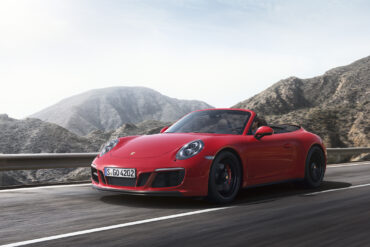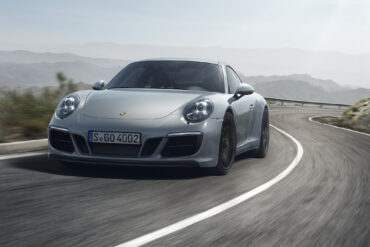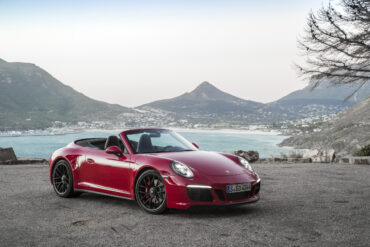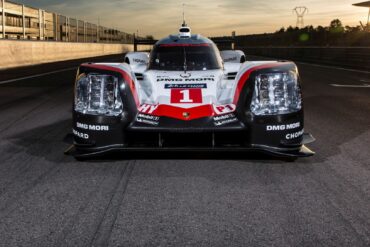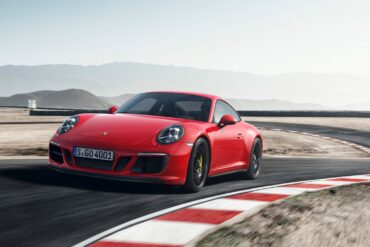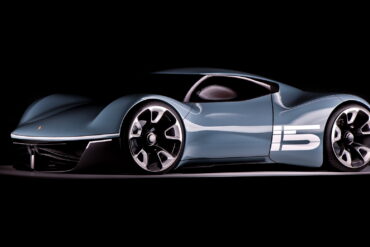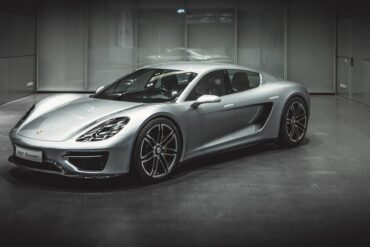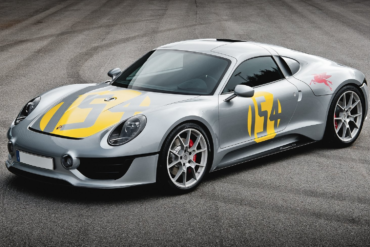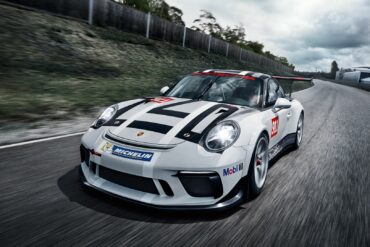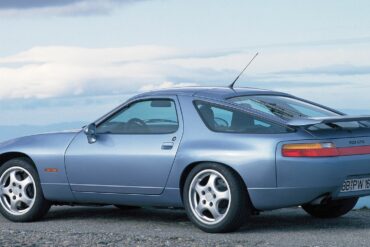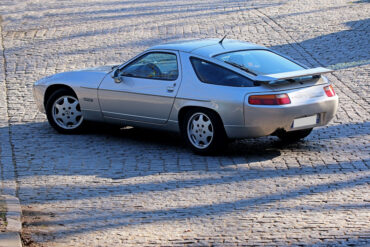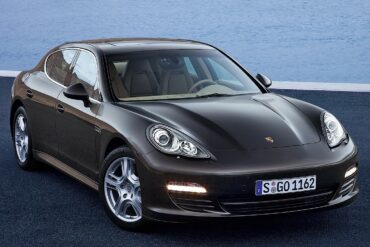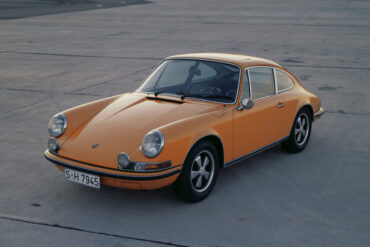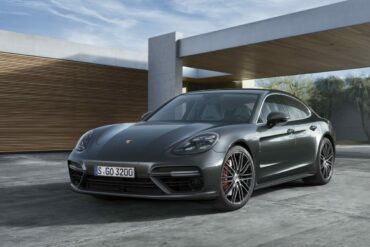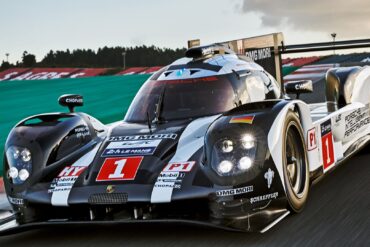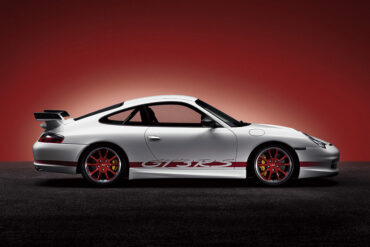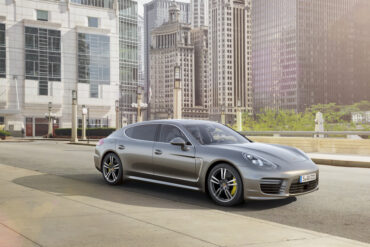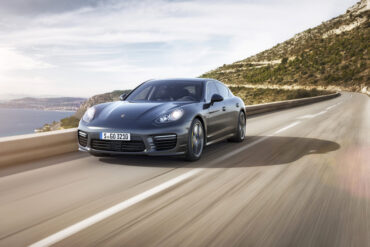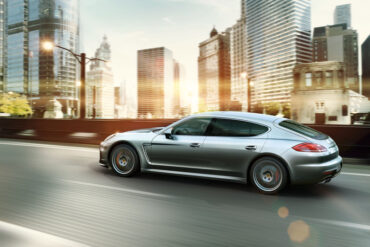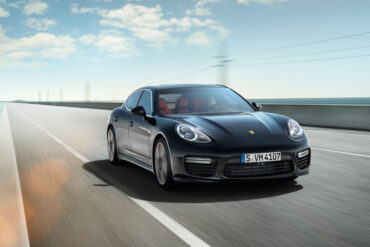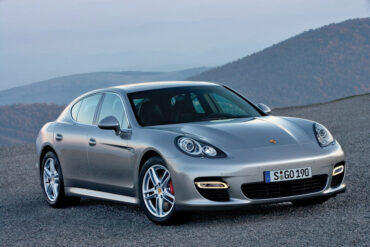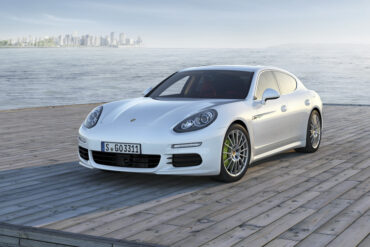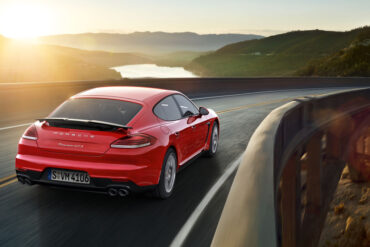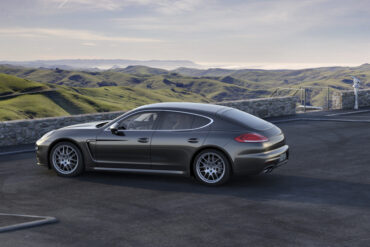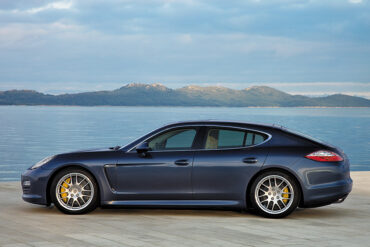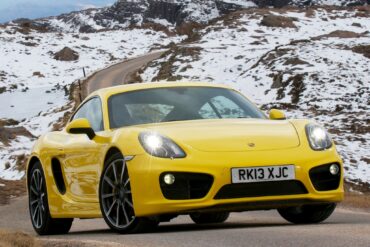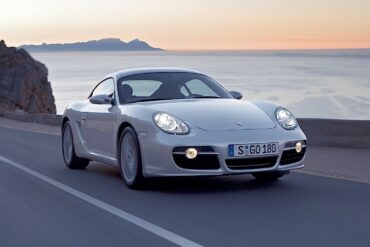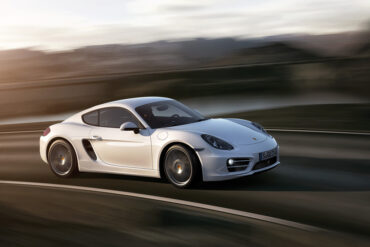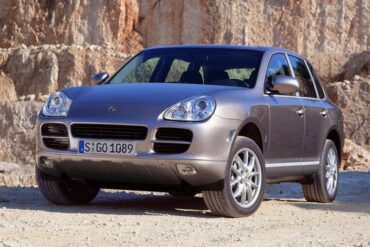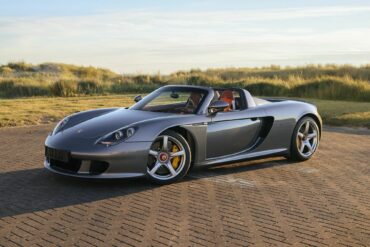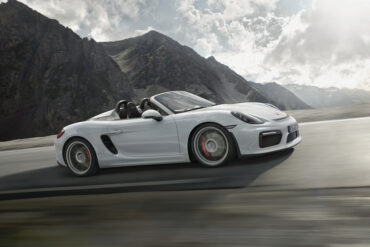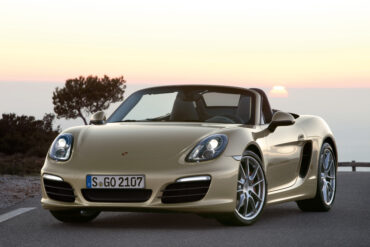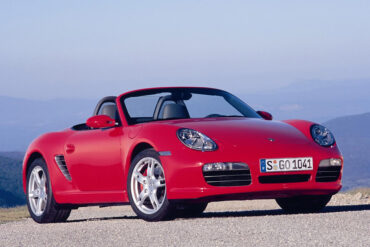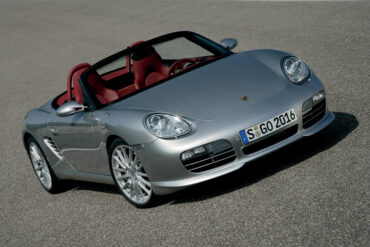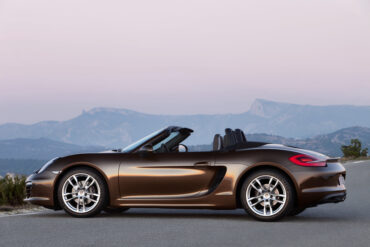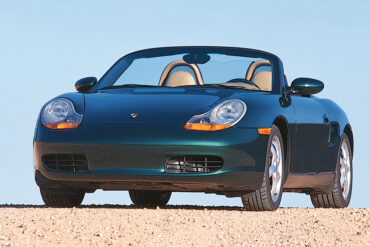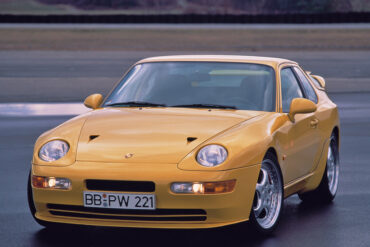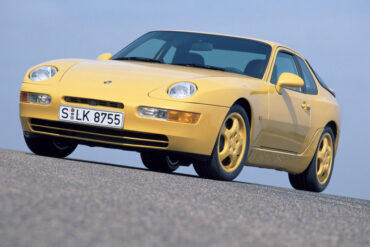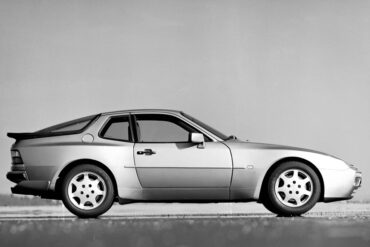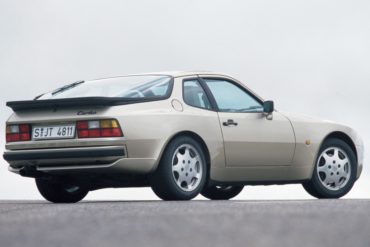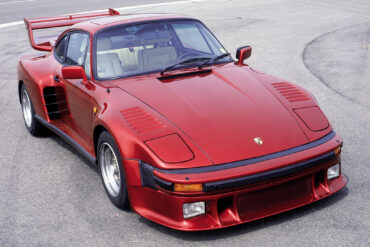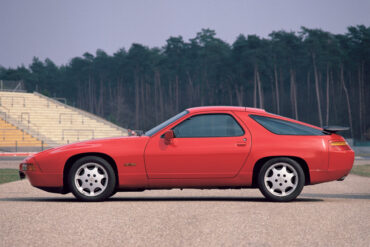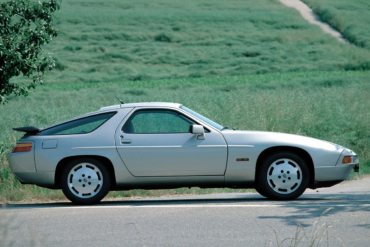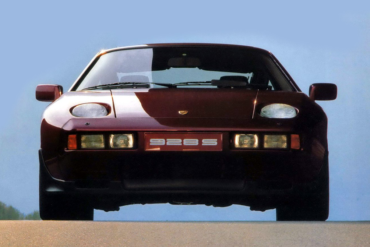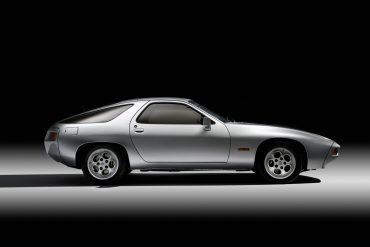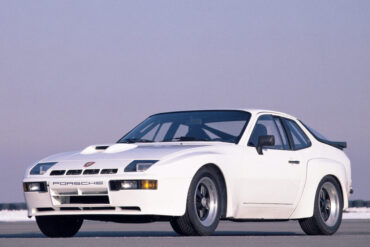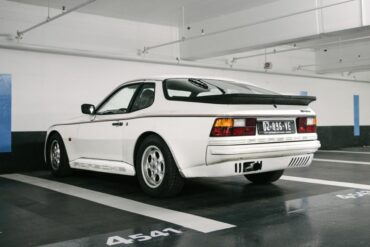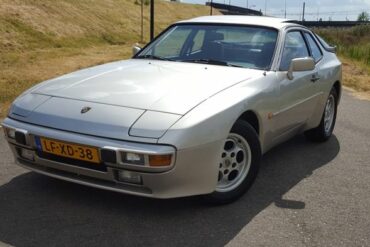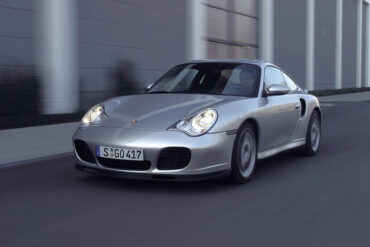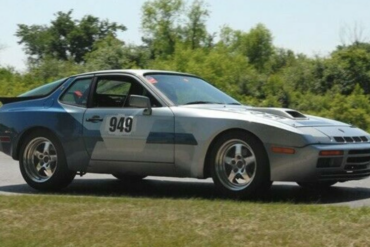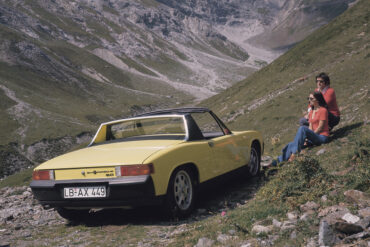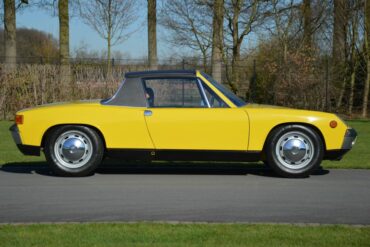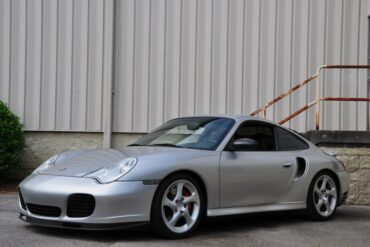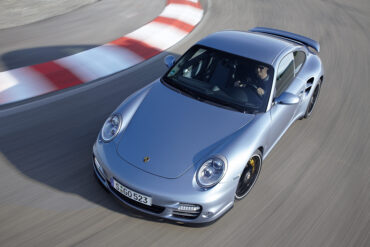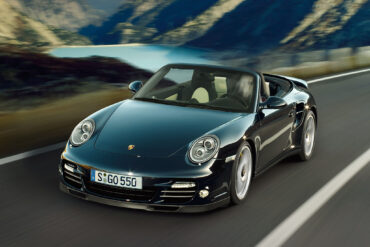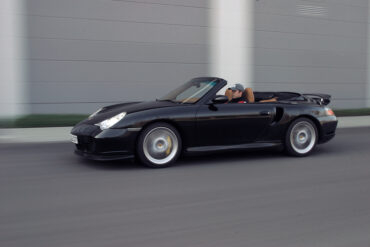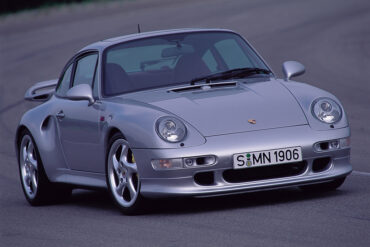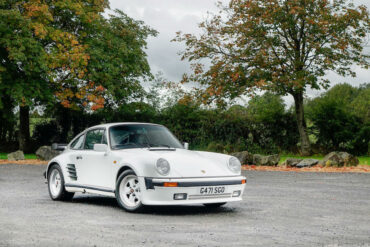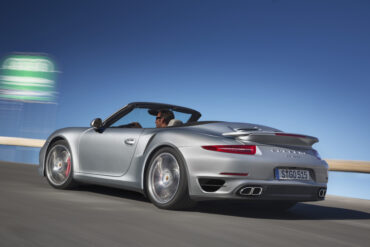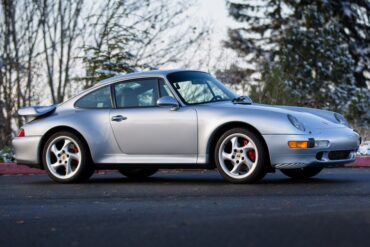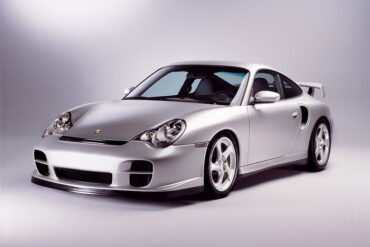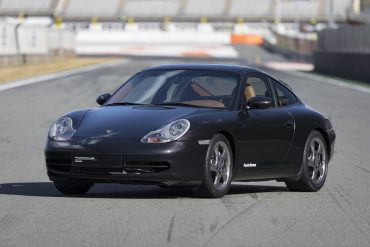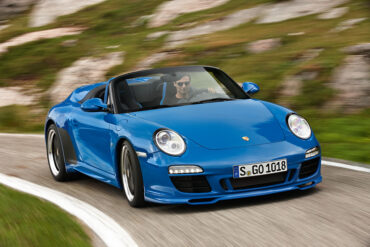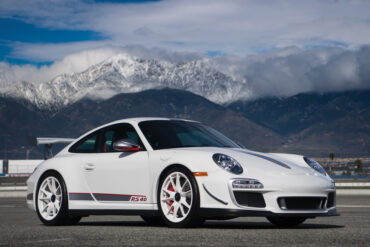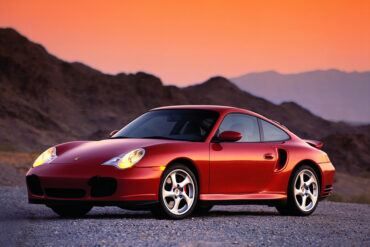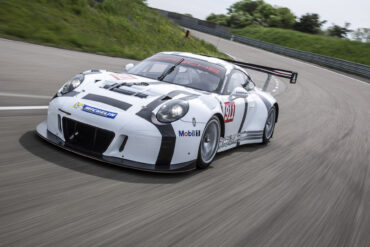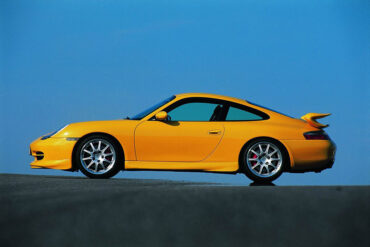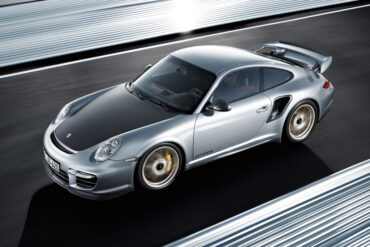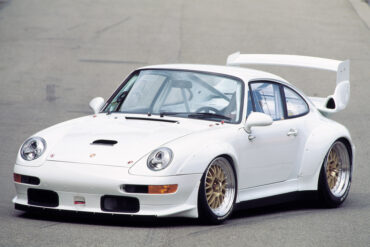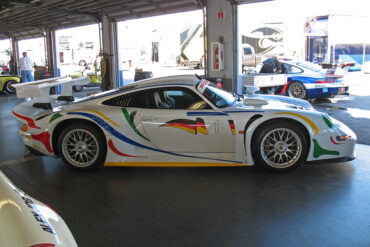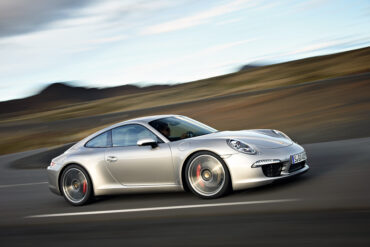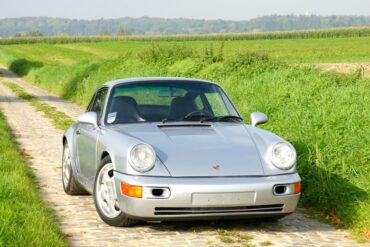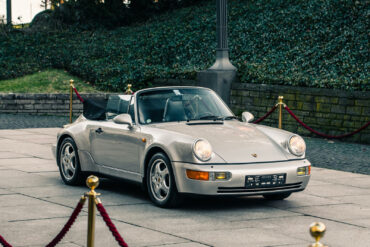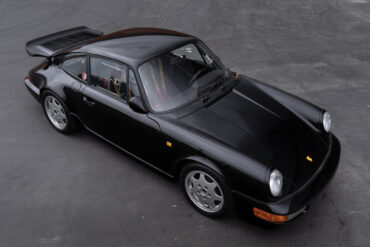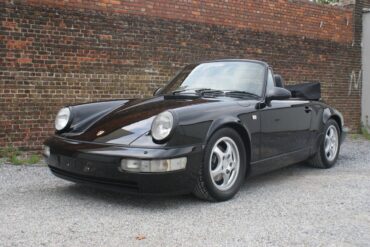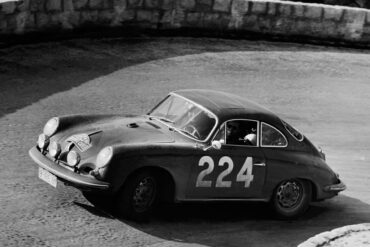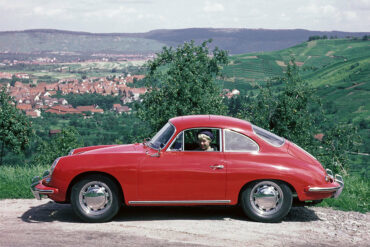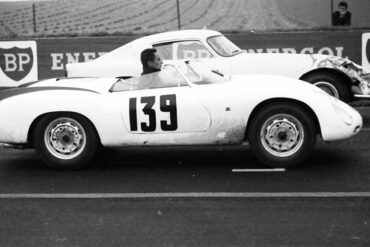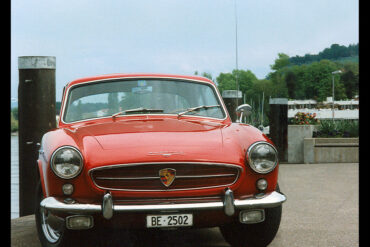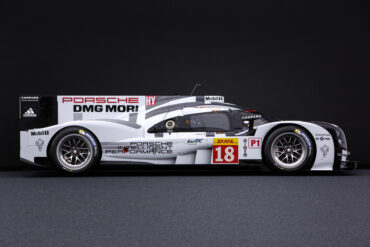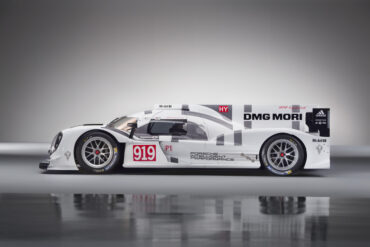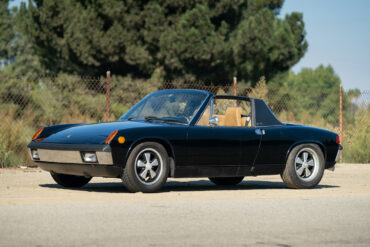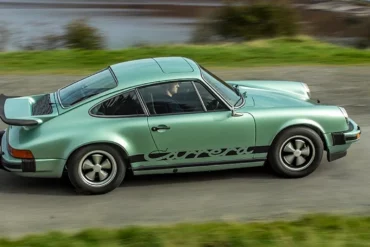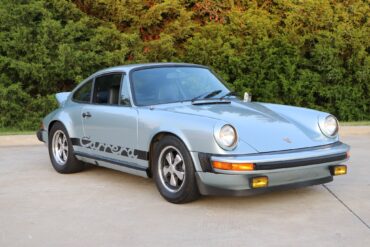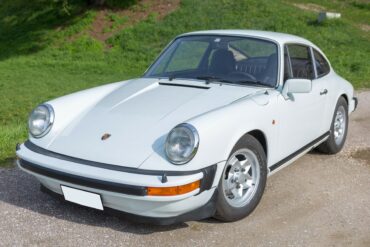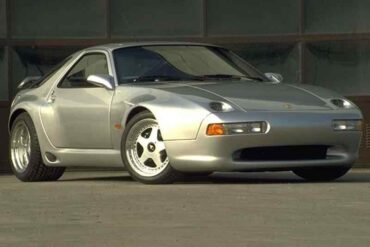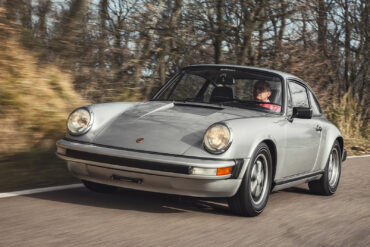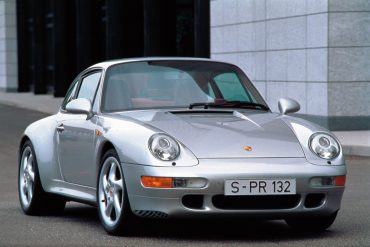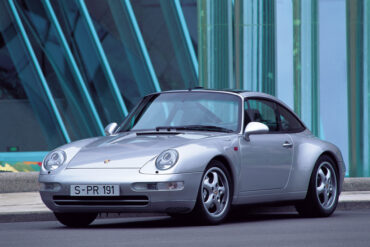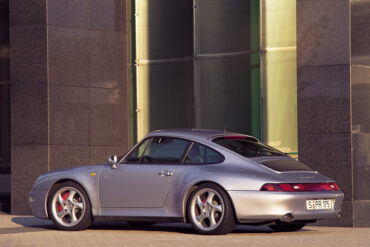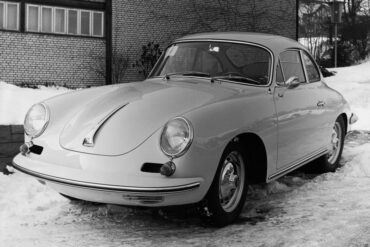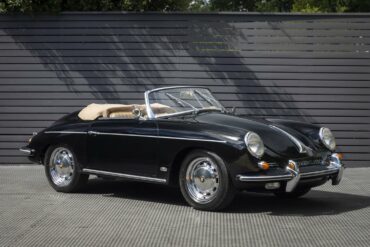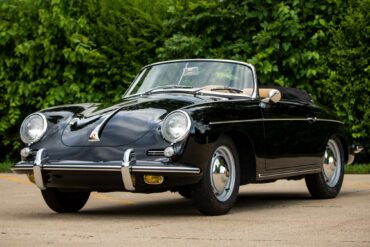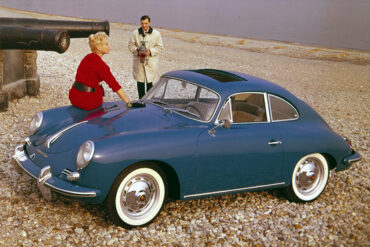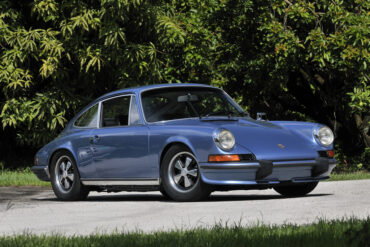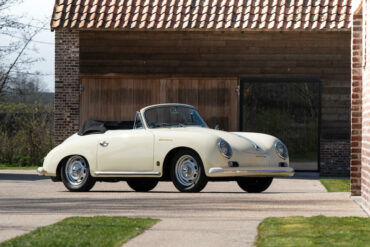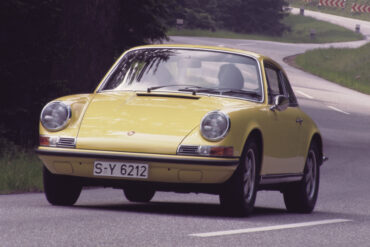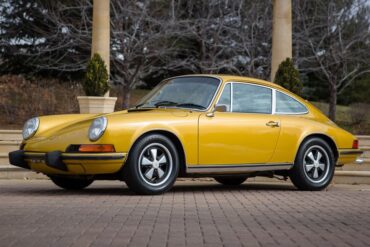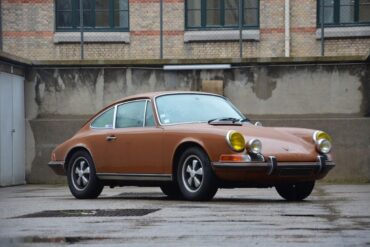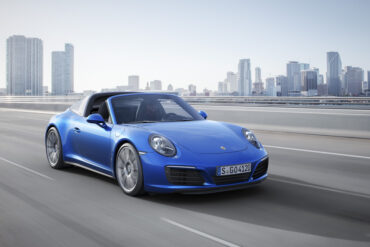The GTS 4 Cabriolet reminds us how awesome Porsche cars are. This is a 911 that can be used as a regular car, an all weather convertible 911 that does everything really well. And when you want to push hard, the car transforms into a true sports car, a car that no enthusiast will ever complain about. Drop-top 911s have always played a supporting role to the fixed roof versions, but in GTS specification the Cabriolet is now better than ever.
Ultimately, the Carrera 4 GTS is the ideal all-round 911. Its bag of tricks gives you accessible, astonishing performance on the right road – but its price tag and comfort levels make it a little more acceptable for everyday use than a GT2, GT3 or Turbo. The GTS scores particularly well on the practicality to performance ratio. Its rear seats can accommodate people and its all-wheel drive system means you can really use this car all-year round. The GTS-spec 3.0-litre flat-six develops 30bhp more than a Carrera S (at 444bhp) and 37lb ft more torque (at 406lb ft).
Porsche really has hit its brief with the turbocharged Carrera GTS Cabriolet. It is hugely capable on the road, easy to live with on a daily basis, and come the weekend, it’s massively fast on track. For the money, and for drivers who really want just a little more 911, but without the mind-bending speed of a Turbo or uncompromising nature of a GT3, then this is the car for you. It also looks unique and has enough of its own style that it it feels special both on the outside and inside.
According to Porsche, it retained the monocoque from 2016, but 60 to 70% of the 2017 car was new, with the largest alterations being to its aerodynamic demands. This included a major redesign of the front of the 919 Hybrid with wider arches for the front wheels to make it less aerodynamically sensitive from small bits of discarded rubber from the track surface. Porsche remained in the 8 MJ (2.2 kWh) MGU category for the 2017 season. The engine was modified to be lighter and more compact, and Porsche stated that it was its most-efficient ever.
The GTS coupe starts with the wider Carrera 4 body, with the rear fenders pushed out 1.7 inches, and the rear track widened 1.6in. Up front is the new SportDesign front fascia with its lower front spoiler and larger cooling air intakes. Standard wheels are 20-inch center lock items and 0.5 inch wider than standard Carrera S rims, finished in satin black. There are splashes of black elsewhere, too. The changes run more than skin deep. Bigger turbos pump up to 18psi of boost pressure which helps deliver not only 30 extra horses at 6,500 rpm, but 405 lb-ft of torque between 2,150 rpm and 5,000 rpm, up from 368 lb-ft. This is the sweet spot.
The basic idea: a study by one of Porsche’s design interns, the Porsche Vision 916 has compact dimensions similar to the Porsche 916, which was developed as a prototype in the early 1970s. However, this Little Rebel is driven purely electrically by four wheel hub motors. It pays homage to the car designer Ferdinand Porsche and his first Lohner-Porsche racing car with four-wheel drive from 1900.
The Porsche 960 Vision Turismo is a mid-size sedan concept, designed and built by Porsche in 2016 that previewed some of the future design cues that Porsche would incorporate into the Porsche 911 (generation 991.2). The creation of the concept happened nearly by accident when somebody saw a sketch of the 918 Spyder and thought it had four doors .
This extreme road sports car based on the Porsche Boxster is reminiscent of the groundbreaking Porsche 550 racing coupé that started in 1953 at the 24 Hours of Le Mans. The front and rear bonnet open in opposite directions and fuel is supplied via a central nozzle at the front. At the rear is an eight-cylinder engine with excessive sound development.
The rear of the world’s most-produced GT racing car now houses a 4-litre, six-cylinder flat engine for even more drive. Thanks to thoroughbred motorsport technology, the compact engine with direct fuel injection delivers peak performance of 357 kW (485 hp). A range of innovative details also improve efficiency in addition to engine performance, ensuring even better durability of the naturally aspirated engine in racing mode and reduced maintenance costs.
The last evolutionary stage of the 928 model featured flared rear wings, a red light panel at the rear, a rear wing painted in exterior colour, exterior mirrors in the Cup design plus 17" Cup rims as standard. The 5.4-litre engine of the GTS generated 350 hp. The 928 GTS came for sale in late 1991 as a 1992 model in Europe and in spring of 1992 as an early 1993 model in North America. Changed bodywork, larger front brakes and a new, more powerful 5.4 L engine were the big changes.
In 1989, 928 buyers had the choice of the S4 or the GT, a better-equipped, manual-only car. The 928 GT was sportier than the 928 S4. Thanks to various modifications, its power unit generated up to 330 hp. The GT was delivered as standard without side protection strips and with wheels in a unique design. It featured a dogleg manual gearbox, a more aggressive suspension, and special seven-spoke Club Sport wheels
The rear-wheel drive and naturally aspirated 4.8-litre V8 make the first Panamera S a great all around passenger car with sports car energy. The Porsche Panamera 4S is an all wheel drive vehicle, with its engine placed in the front, and a 4 door saloon (sedan) body. The Porsche Panamera 4S belongs to the 970 range of cars from Porsche. Power is supplied by a double overhead camshaft, 4.8 litre naturally aspirated 8 cylinder motor.
1970 Porsche 911 S 2.2 Coupé Along with all the C-series improvments to the 911 line, the 1970 Porsche 911...
2017 Porsche Panamera The new Porsche Panamera was announced yesterday. We like it. It’s one hell of an upgrade vs the...
The third-generation 919 Hybrid (2016 MY) is powered by a turbocharged four-cylinder, two-litre petrol engine delivering almost 500 hp that drives the rear axle. The V4 engine, which is fully load-bearing, is turbocharged and features 4-valves per cylinder, DOHC, a Garrett turbocharger, direct fuel injection and an aluminium cylinder crankcase. In addition, the electric motor delivering more than 400 hp to the front axle. The latter is fed by two energy recovery systems.
The 996 GT3 RS was a sharpened version of the Mk.2 GT3, built for track use and it was the homologation model for the GT3 race-car. It was the forbidden fruit for the U.S. and Canadian customers. It was available in a limited number and it was a true track-oriented vehicle. It was based on the GT3 version, but with fewer comfort features and even stiffer suspension. It was the kind of car which could have been taken from the shop and dive into the first race-track. The GT3 was available in white color only, with red or blue inscriptions on its sides. The adjustable rear wing and the “duck-tail” were mounted in the back, to provide better traction on higher speeds. It was fitted with the same engine as the GT3.
For the first time ever, an Executive version of the Panamera Turbo S is also available with a wheelbase that has been extended by 15 centimetres. As a result, the Panamera Turbo S Executive offers significantly more space and even more comfort, particularly at the rear. Thermal and noise-insulated windows, which include privacy glazing, the interior lighting package designed especially for the rear and a large centre console at the rear are just some of the extensive equipment options that belong to this series.
The sporty, luxurious character of the new Panamera Turbo S is evident not only in its driving performance but also in the key distinguishing features of its appearance. The Palladium, metallic exterior colour, which is available solely for the new Panamera Turbo S. Porsche added 50 additional horsepower than the Panamera Turbo. The 4.8-liter V8 turbocharged engine was mated to a standard PDK 7-speed automatic gearbox and gets PCCB (Porsche Carbon Ceramic Brakes) fitted as standard.
The big news for 2014 was the introduction of an all-new Panamera Turbo executive model. It featured a 15 cm (5.9”) longer wheelbase than the Turbo. It was built to offer more legroom in the back. Strangely though, it was built especially for the Chinese market, where the long-wheelbase version of a car, any car, was considered an executive car by default. Basically, the Executive Panamera is an excuse for Porsche to elongate a Panamera Turbo by nearly six inches for an extra $19,800. All of the legroom goes to passengers in the back.
The Porsche Panamera Turbo got an update at the same time as the rest of the Panamera lineup for the 2014 model year. The 2014 Panamera Turbo got the same twin-turbo 4.8-liter V8 unit but now with more power. Power was 520 hp instead of 500 hp and it was coupled to the same 7-speed (PDK – double-clutch) automatic gearbox as before, but with a different final drive ratio. The Turbo was fitted with the PTM (Porsche Traction Management) all-wheel-drive system. With the Porsche Chrono Package, the car received an extra boost when needed.
As a top of the range version, the Panamera Turbo featured the same 4.8-liter V8 engine from the S-version, but with a pair of turbochargers that increased the power from 400 hp to 500 hp. It was available exclusively with a 7-speed automatic (PDK double-clutch) gearbox and all-wheel-drive. Inside, the Panamera Turbo designers took their inspiration from the Vertu luxury mobile phones, with high end appointments throughout. This is one quick and sporty sedan.
Porsche is introduced the world’s first plug-in hybrid to the luxury class. The Panamera S E-Hybrid far exceeds the driving performance of the previous model. The Panamera S E-Hybrid is a systematically advanced development of the parallel full hybrids with a more powerful electric motor, a higher-performance battery that supplies more energy and the ability to charge it externally from the electrical grid. The acceleration time from a standstill to 100 km/h was shortened by half a second to 5.5 seconds.
More power and upgraded brakes, a body lowered by ten millimetres and the especially sportily tuned chassis with air suspension and PASM are the major technical modifications that make it the Panamera model capable of cutting it on the racing circuit – without sacrificing practicality. The power unit in the new Panamera GTS is a modified 4.8-litre naturally aspirated V8 engine, delivering 434 hp (316 kW) at 6,700 rpm, while maximum torque also increased from 500 Nm to 520 Nm.
The biggest change for the 2013 Panamera S was under the hood, where a twin-turbo 3.0-liter V6 engine was installed. It replaced the older 4.8-liter naturally aspirated unit. It was a win-win combination since it offered 20 hp more and it was more fuel-efficient. Unlike its predecessor, it was available exclusively with a 7-speed automatic (PDK – dual-clutch). The all-wheel-drive system was carried over, but the final drive was different to allow better fuel-efficiency.
For the drivetrain, Porsche chose Cayenne as an inspiration model installing the 4.8-liter V8 engine under the hood. For the Panamera 4S, it fitted the car with an all-wheel-drive system and a 7-speed automatic (PDK – double-clutch) gearbox. The 400 hp Porsche 4-door hatchback was good for a 5-second run from 0 to 100 kph (0-62 mph).
For 2013, Porsche gave us the new 981 generation Cayman. The Cayman S engine displacement is unchanged at 3.4 liters. Power is increased by 5 horsepower to 325, shooting the S from 0-60 mph in just 4.4 seconds while delivering as much as 30 miles per gallon (PDK & Sport Chrono+). There are two transmissions choices available in the 2013 Caymans, both carrying over from 2012. The Cayman S come standard with the 6 speed manual gearbox and 7 speed PDK was available as an option. The 981 Cayman S is arguably the best all around sports car that Porsche offers, the right balance between being fun and usable daily.
After the initial announcement that Porsche was going to release a small mid-engine coupe, we were all excited. In 2005 we finally got the Cayman S. A fast, mid-engine coupe in the Porsche lineup, starting with the S version as a 2006 model year car (the base model came a year later). The 2006 Porsche Cayman S was based on the Boxster series, the two-seat coupe incorporated dramatic new styling, a powerful 295 hp (SAE) engine, and features and options made popular by Porsche's current range of sports cars.
The 2013 model year saw the introduction of an all new platform, the new 981 Cayman. The differences between the 981 and 987 were significant, but not unexpected as many of the new technologies were already introduced in the new 991 and 981 Boxster. This is a big year with lots of changes in many areas. The base engine for the Cayman was a 2.7-liter flat-six unit that boosted out 236 hp and it was mated to a standard 5-speed gearbox. A 5-speed Tiptronic sequential gearbox was available as an option.
The first-generation Cayenne Turbo 955 has 450 PS (331 kW), and can accelerate from 0–100 km/h (62 mph) in 5.3 seconds. Under the hood, the Cayenne Turbo was fitted with a turbocharged 4.5-liter V8 unit mated to a standard 6-speed automatic. Thanks to the standard air-suspension, the Turbo version could get up to 28 cm (11”) of ground clearance. The German brand needed a car to sell in volumes and save them from a foreseeable financial collapse. The Cayenne Turbo did just that.
Porsche's open-top, 603-hp, manually shifted Carrera GT makes other supercars seem quaint. It is arguably the best supercar ever made. Under the skin, the car used many modern hallmarks of motor sport engineering: a carbon fiber chassis, dry sump lubrication, inboard suspension and a mid-mounted engine that was engineered to sit as low as possible to ground. Performance on paper and in person was spectacular. Peak supercar.
Following in the footsteps of the nineteen fifties and sixties 356 Speedsters, 550 Spyders, different 718 Spyders and the two thousand ten Boxster 987 Spyder, the Boxster 981 Spyder is by far the most powerful of them. The power-to-weight ratio of the original 718 Spyder 1.7- and 2.0-litre 4-cylinder models was better though already 55 years earlier. Visually the Porsche Speedsters and Spyders are characterized by their unique side view silhouette - the result of the low windscreen and low roofline when the temporary canvas top is fitted.
Unlike its Boxster brother, the S version of the mid-engined Porsche roadster offered a 3.4-liter unit from its predecessor, but with some improvements and a lower vehicle mass. It offered 311 hp and enough torque to push the car to 100 kph (62 mph) in 4.8 seconds if the car was fitted with PDK (automatic dual-clutch). The two-seat roadster featured a clean design interior, with influences from the Carrera GT super sports-car. The Boxster S was the sweeter of the two models.
The second generation of Porsche Boxster came out in 2004 at the Paris Motor Show and shared almost the same design with its predecessor. The Boxster S came with the 3.2-liter flat-six engine mated to a standard 6-speed manual transmission, while a 5-speed Tiptronic S (automatic) with manual override to select gears was on the options list. The Porsche Stability Management was fitted as standard. It got a bump on power over the prior generation Boxster S as well as a newly modernized exterior design. The interior was also upgraded and was much nicer.
In November 2007, Porsche announced a commemorative RS60 Spyder edition of the Boxster to celebrate Porsche's 1960 win in the 12 Hours of Sebring in Florida. Only 1,960 units were produced worldwide with each model bearing a numbered production badge on the dash. The RS60 Spyder came only in GT Silver Metallic exterior colour while the standard interior is Carrera Red leather, with dark gray leather as an option. The RS60 came standard with 19 inch SportDesign alloy wheels, Porsche's Active Suspension Management System, and a sports exhaust that increased the engine output to 303 PS (299 hp; 223 kW).
The third generation Boxster was a bigger car than the 987 it replaced, but it was also lighter and more powerful. The 2013 model year Boxster went through a downsize program and received a 2.7-liter boxer engine, which was 0.2-liter smaller than its predecessor. With 261 bhp @ 6700 rpm and 206 ft lbs @ 4500 rpm the base Boxster still felt underpowered to many. The base 981 Boxster got a 6-speed manual gearbox or you could opt for an optional 7-speed reworked PDK. The base car is plenty fast but if it were our money, we would opt for the more powerful Boxster S.
It was Porsche's first road vehicle to be originally designed as a roadster since the 914. The first-generation Boxster (the 986) was introduced in late 1996 as a 1997 model year car. The V-Series Boxster 2.5 rolled out in August 1996 from Porsche’s factory in Zuffenhausen, Germany. The design was heavily influenced by the 1993 Boxster Concept (which was a good thing). It was an instant success, becoming Porsche's biggest seller from its introduction in 1996 until the introduction of the Cayenne sport utility vehicle in 2003.
In 1993, Porsche Motorsports at Weissach briefly produced a turbocharged 968 Turbo S. The 968 Turbo S shared the same body and interior as the Club Sport and visually can be identified by the NACA bonnet hood scoops, adjustable rear wing, three-piece speedline wheels and deeper front spoiler. The 968 Turbo S was powered by a 3.0 L engine with a 8-valve SOHC cylinder head (from the 944 Turbo S) and 944S2 style engine block. 0 - 60 mph in 4.5 seconds and a top speed of 175 mph.
From late 1992 through 1995, Porsche offered a lighter-weight "Club Sport" version of the 968 designed for enthusiasts seeking increased track performance. Much of the 968's luxury-oriented equipment was removed or taken off the options list; less sound deadening material was used and power windows were replaced with crank-driven units. Upgraded stereo systems, A/C and sunroof were still optional as on the standard Coupe and Convertible models.
In 1988, Porsche introduced the 944 Turbo S with a more powerful engine (designation number M44/52) rated at a maximum power output of 250 PS (184 kW) at 6,000 rpm and 350 N⋅m (258 lb⋅ft) of torque at 4,000 rpm (the engine in the standard 944 Turbo generated 223 PS (164 kW) and 243 lb⋅ft (329 N⋅m)). This higher output was achieved by using a larger KKK K26-8 turbocharger housing and revised engine mapping to maximize boost for longer.
It didn’t take Porsche’s engineers long to significantly improve on the base 944’s performance by doing the obvious and adding a turbocharger to the engine. The 944 Turbo entered production in 1985 for the 1986 production year and it made a significant difference to the stock 944’s performance. Power of the new turbocharged engine was 220hp and torque was 243lb/ft, a significant increase over the naturally aspirated standard 944.
In 1983 Porsche produced a stunning one-of road car for TAG owner Mansour Ojjeh. Based on a 934 chassis, it was designed to mimic the potent 935 racecars and subsequently became the one of the first slantnoses. Both the front and rear sections were made similar to the potent 935 race car which dominated the Group 5 Championship. This silhouette series allowed radical modifications which contributed to the repositioned nose, ultra-wdie flares and extended rear bodywork.
The Clubsport was up to 100 kg (220 lb) lighter and became available in 1988. This model was the toned-down version of the 1987 factory prototype which had a lightened body. In 1987, the factory made five white lightweight S4 models with a manual transmission for racecar drivers. The Special Equipment (SE) was a more complete version of the CS, in which some accessories lost in the CS are added back again.
The 928 S4 variant debuted in the second half of 1986 as a 1987 model, an updated version of the 5.0 L V8 for all markets producing 235 kW; 316 hp (320 PS), sporting a new single-disc clutch in manual transmission cars, larger torque converter in cars equipped with automatic transmission cars and fairly significant styling updates which gave the car a cleaner, sleeker look. S4 was much closer to being a truly world car than previous models with only small differences across markets
To replace the base 928, a refreshed 928 S was released in Europe in the 1980 model year (1983 for North America). The S wore new front and rear spoilers and sported wider wheels and tires, but the main change was a revised 4.7 L engine. In 1985, North America got a new 5.0 L 288 hp 32-valve engine with Bosch LH-Jetronic injection. Mid-year 1986 models incorporated the upgraded suspension and Brembo brakes.
The Porsche 928 was the company’s first production car with a V-8 engine and the only coupe powered by a front-mounted V-8 as of today. Developed in the 1970s as a replacement of the 911, the 928 was eventually sold alongside the rear-engine sports car. Production lasted from 1977 until 1995. What people saw was a sleek if rather heavy-looking 2 + 2 hatchback coupe unlike anything else on the road -- a sort of German Corvette.
After the end of production of the 400 Porsche 924 Carrera GT road sports cars at the beginning of December 1980, a small evolution series of pure competitive cars was launched: the Porsche 924 Carrera GTS. The two-liter engine of the Porsche 924 Carrera GTS turbo-charged with a maximum of 1.0 bar and classified in Group 4 according to the FIA Regulations developed 245 hp (180 kW) at a speed of 6,250 revs./min. and accelerated from 0 to 100 km/h in 6.2 seconds.
In spring of 1984 Rothmans cosmetic edition 944 was made, a batch of 100 numbered cars ordered by the French importer Sonauto (the subsidiary of Porsche AG) to celebrate the victorious Rothmans-sponsored Porsche 956 that had won Le Mans 24 hour race in France in 1982 and in 1983. At the time when the Rothmans 944 was sold, Rothmans-Porsche factory team decided to boycott the 1984 Le Mans race. Only 100 were produced.
The Swiss Special 944 was a very limited edition 944 Special produced in 1984. Only 200 944 Swiss Specials were produced and it was largely a design exercise, with several upgrades to the normal 944. The changes included, Red-colored stickers on the back of "Porsche” “944", Special size teledial rims, Seats , rear bench and door panels in 924 Carrera GT fabric and dashboard plastic parts in black instead of the standard silver.
The 2005 Porsche 996 Turbo S was available as both a coupe and cabriolet – it was basically a standard Turbo model with the X50 Powerkit and carbon-ceramic brakes fitted, alongside a few luxury features for the interior. Approximately 1558 Turbo S models (split between coupe and cabrio) were sold in 2005. Also included are small aluminum appointments to the interior and Turbo S badging. A great all-rounder with the extra power to surprise most. The Turbo S with manual transmission (coupé) sprints from zero to 200 km/h in 13.6 seconds. This is another 0.8 seconds faster than the 911 Turbo. Quite rare, with only a total of 600 units made.
In 1983, American tuning company Callaway Cars began offering a turbocharged package for the US-Spec 944 in collaboration with Porsche. The standard 2.5 L inline-four engine was not suitable for forced induction because of the higher compression ratio of 9.5:1 which made the engine prone to failure when subject to forced induction along with the complex Bosch Motronic engine management system.
This came in 1973, when the fuel-injected variant of Volkswagen’s air-cooled Type 4 engine was dropped in behind the two seats, staying there through 1976, when series production ended. (The engine continued on in the 912E, which succeeded the 914 as Porsche’s entry-level car.) The short-stroke, overhead-valve powerplant displaced 2.0 liters (1971 cc) and made its 100 hp at 5000 rpm, whereas the six had made 110 hp at 5800 rpm. Yet the four matched the six’s torque output of 118 lb-ft, achieving this figure at 3500 rpm instead of 4200 rpm. And it was lighter in weight.
The Porsche 914 was first shown at the 1969 Frankfurt Auto Show was, as intended, a true conglomeration. The front suspension was largely derived from the 911 with some VW components, and the interior was a blend of both companies' parts bins. The initial engine offering was Volkswagen's 80-hp fuel-injected 1.7 liter flat four, while the 914/6 had a twin-carburetor 2.0-liter Porsche flat six tuned for 125 hp.
The optional X50 Performance Package gave the base Turbo larger K24 turbochargers and intercoolers, a revised ECU and a quad-pipe exhaust, raising the engine’s output from 415 to 450 bhp and maximum torque from 415 to 457 ft lbs. With power at 450 bhp @ 6000 rpm and torque of 457 ft lbs @ 4400 rpm, the X50 option is a monsters. Porsche engineers achieved the increase in power and performance through modifications to the Turbo charger, the change air cooler, the control units and exhaust system in particular. The base constructions of the manual and automatic transmissions were also improved.
The heart of this most exclusive high-performance athlete is of course a six-cylinder boxer boosted by two exhaust gas turbochargers with variable turbine geometry, with an increase in power over the 911 Turbo by 30 to 530 bhp (390 kW). Maximum torque is a most impressive 700 Newton-metres (516 lb-ft). At the same time this new top model comes as standard with all high-tech components available only as options on the “regular” 911 Turbo. The 911 Turbo S comes exclusively with seven-speed Porsche-Doppelkupplungsgetriebe (PDK) conveying drive power to PTM all-wheel drive.
The heart of this most exclusive high-performance athlete is of course a six-cylinder boxer boosted by two exhaust gas turbochargers with variable turbine geometry, with an increase in power over the 911 Turbo by 30 to 530 bhp (390 kW). Maximum torque is a most impressive 700 Newton-metres (516 lb-ft). At the same time this new top model comes as standard with all high-tech components available only as options on the “regular” 911 Turbo. The 911 Turbo S comes exclusively with seven-speed Porsche-Doppelkupplungsgetriebe (PDK) conveying drive power to PTM all-wheel drive.
Towards the end of the 996 production run, Porsche introduced the Turbo S, boasting even more power than the standard 996 Turbo — 450 PS (331 kW) and 620 N·m (457 lb·ftf)— courtesy of the X50 package being standard. The Turbo S was limited to approximately 1,500 units worldwide, of which 598 were coupé (hardtop) and 960 were cabriolet (convertible). It was available with a 6-speed manual or an automatic (Tiptronic S) transmission, driving power to all four wheels. The basic price is EUR 122,500 for the Turbo S Coupé or EUR 131,100 for the Turbo S Convertible. Sprints from zero to 200 km/h in 13.6 seconds.
The 993 Turbo S, available between 1997 and 1998, bumped the power from the standard 993 Turbo up to 450hp (430 for the United States market) with larger turbochargers and a modified engine management system. The Turbo S was fitted with more luxury trim bits on the interior – with more leather and carbon fiber than on the standard Turbo. A larger rear wing was installed as well. Only 345 were built. Its direct successor was the 996 Turbo S for model year 2005.
Only 50 units made. The 911 Turbo Limited Edition comes equipped with the 330 bhp power unit normally only available in the 911 Turbo with Sport Equipment. In addition, the fitment of a limited slip differential as standard ensures the the increased engine performance can be used to it’s fullest extent. This Limited Edition also adopts the rear wheel air intakes of the Sport Equipment version. Essentially an SE without a slantnose front.
2013 Porsche 911 Turbo Cabriolet Stuttgart. The dynamic range of the new 911 Turbo models1) multiplied by the driving pleasure...
The 993 Turbo was available between late 1995 to 1998. Powered by a twin-turbocharged 3.6 liter flat six, it was rated at 402-horsepower. It’s distinguished easily from the rear, as the whale-tail spoiler is quite deep to house the intercoolers meant to cool the intake charge. This extra power might have been a handful for street drivers, so all-wheel drive from the 993 Carrera 4 added traction at all four corners. Approximately 6,000 coupes were made. Although powered by a different engine, a limited production 993 Turbo Cabriolet was available in the early days of the 993 generation. A more powerful 993 Turbo S was also introduced in 1997.
From model year 2001, the model range was extended to include the 911 GT2. The body of the extreme sports car was based on the body of the 911 Turbo. The GT2 engine was also based on the 911 Turbo but had ten percent more power. The bi-turbo engine delivered 462 horsepower. The GT2 was offered with a Clubsport Package for use in motorsport. In late 2003 the Porsche 911 GT2 received a power upgrade from 462hp to 483hp, maximum torque also increased from 457 lb ft to 472 ft lbs, thanks to a revised engine management program. Top speed increased by 2mph to 198mph while 0-60 is claimed to take 3.8 sec.
In 1999, Porsche celebrated the turn of the century with a special edition – the 996 "Millennium Edition". The 911 Millennium edition was based on the Carrera 4 coupé and was pretty rare, with only 911 cars made. Based on the Carrera 4, the "Millennium Edition" was limited to 911 examples and was based exclusively on the wide bodied Carrera 4. This special edition was finished in Violet Chromaflair paint, which, depending on the light changes from dark violet to light green and is quite spectacular to look at. It also got a caramel-colored leather interior and polished "turbo-twist" wheels.
Paying homage to the first Porsche model that bore the name Speedster – the 356 Speedster – the production run for the new model is limited to 356 cars. The two-seater is significantly different from the other members of the 911 family. In the best tradition, the 60 millimetre lower, more raked windscreen, the flat contour of the sporty-look manual hood, and the characteristic double-bubble hardcover for the soft top define the striking profile of the new 911 Speedster. This makes the body of this rear-wheel drive with its 44 millimetre wider rear stand out even more.
This is the best 911 Porsche has ever made. The headline power figure and the ability to rev to 8,500 snare your attention, but the most staggering aspect of this engine is actually its tractability. Mid-range lunge is marvelous, even if the peak number of 339 pound-feet doesn't sound huge in the context of short gear ratios, lightweight, and a compact frontal area. In third gear, the way this thing flies between 4,500 and 8,500 rpm is scintillating. Plus, the utter progression of the delivery makes it vastly easier to take advantage of compared to the GT2's ridiculous turbo surge. This is one special car.
Porsche introduced the turbocharged version of the Type 996 for the 2001 model year (late 2000 in Europe). Like the 996 GT3, the Turbo's engine was derived from the engine used in the 911 GT1. Like its predecessor, the 993 Turbo, it featured twin-turbos but now had a power output of 420 PS (309 kW; 414 hp). As of 2002, the X50 package would increase engine output to 444 hp. The 996 Turbo was available with a 6-speed manual transmission or an automatic (Tiptronic), driving power to all four wheels. This is a great great car.
Based on the 911 GT3 RS production sports car, Porsche has designed a customer sport race car for GT3 series around the world: The 911 GT3 R. In developing the more than 368 kW (500 hp) racing nine-eleven, special attention was paid to lightweight design, better aerodynamic efficiency, reducing consumption, improved handling and optimised safety. The 911 GT3 R features the distinctive double-bubble roof, and the wheelbase which had been lengthened compared to the prior generation.
The GT3 was based on the standard 996 Carrera, but was stripped of a great deal of equipment for weight savings, featuring stiffer, adjustable suspension and upgraded brakes. The GT3 used the bodyshell of the four-wheel-drive Carrera 4, which incorporated additional front-end stiffening. It featured a naturally aspirated 3.6-litre flat-six engine generating a maximum power output of 360 bhp @ 7200 rpm and torque of 273 ft lbs @ 5000 rpm. This engine was shared with the 996 Turbo and was a derivative of the engine developed for the 911 GT1 race car.
Porsche’s 911 GT2 RS is a brute, a lightweight, twin-turbocharged, 620-hp bout of madness that stemmed from Stuttgart’s quest to see how high up the sports-car ladder the 911 could punch. It is the most serious roadgoing Porsche ever. The engine is a port-injected, 3.6-liter flat-six from the Le Mans–winning GT1 race car of the late ’90s, with a pair of variable-geometry turbochargers huffing a maximum of 23.2 psi of boost into the combustion chambers. The result is 620 hp at 6500 rpm and 516 lb-ft of torque at 2250. It gets a six-speed manual gearbox and rear-drive only. Yikes.
The Porsche 911 GT2 Evo represented the top specification ever produced for any air-cooled Porsche. Designed to compete in FIA GT1, it incorporated a twin turbocharged 3.6L flat-6 engine rated at a full 600 HP and 491 lb-ft of torque. As compared to the standard 993 GT2, Porsche widened the rear fender extensions to cover wider modular wheels and added a new front spoiler with inlets for oil and brake cooling. A second deck appeared on the already outlandish rear spoiler, which could be mounted higher in the air stream for added downforce. Approximately 11 samples were produced.
To comply with homologation requirements, Porsche built two street versions of their 1996 Le Mans contender. These pre-production cars are essentially the same as the race version without all the safety equipment, a higher ride height and more interior amenities. The two street versions were actually built in 1995 as 1996 model year cars. The engines were slightly detuned from 600 bhp to 544 and the gear ratios were changed.
2012 Porsche 911 Carrera S Coupé The sixth generation 911 was revealed 2011 Frankfurt Motor Show as an all-new model....
The 964 Carrera RS (Standard) was introduced by Porsche for model year 1992 specifically for the European market as a lightweight, high performance version of the 964 Carrera 2. It featured a revised version of the standard 3.6 liter engine, titled M64/03 internally, with an increased power output of 260 bhp (194 kW; 264 PS). The RS does not look much different from the other 911 models of the period but its weight is reduced and power increased. True to its racing spirit, the Carrera RS featured bucket seats and thinner materials, but lacked power windows, air conditioning, air bags, and other creature comforts.
Porsche 911 Type 964 Carrera 2 'Works Turbo Look' Cabriolet was a special model in the 964 lineup. It gave buyers of the Carrera 2 Cab the great wide look of the Turbo cars and the Carrera 2 engine. The model was available as a 1992 and 1993 model year car (while some argue it was also available for a while in 1994). You get body shape of the 964 Turbo 3.3 without the huge rear spoiler. But this was more than just a design exercise, because the the Turbo-Look models also got the chassis and braking system from the Turbo 3.3 too.
The rarest 964 RS variant was the awesome 964 C4 Lightweight. Known as the 964 Leichtbau it made use of surplus parts from 953 Paris-Dakar project. A handful of specially prepared lightweight 911s were fabricated by the Porsche factory and called the Carrera 4 RS Lightweight. Carrera RS Body with 959-like AWD wizardry and more power. Lightweight masterpiece. Used parts from 953 Paris-Dakar project. The 964 C4 Lightweight was powered by the same 3.6 liter flat six as the normal 964 RS, but was fettled to produce 300 hp.
The Carrera 4 model also launched with a Cabriolet version in 1989 (for 1990 model year). The new 911 generation is introduced in Autumn 1988, but the convertible was not launched until the model year 1990. Alterations to the body include the bumpers and sill tread plates, and the 911 continues to be equipped with an automatically retractable rear spoiler and a cowled underbody. The braking system is fitted with ABS. The 911 (Type 964) also features power-assisted steering for the first time. Like the Coupe, the Cabriolet got the new all-wheel drive system.
Amongst Porsche 356 enthusiasts, perhaps no model is more coveted than a C-Series Carrera 2. The Carrera 2 represents the culmination of Porsche’s racing technology fitted into a road car package and the ultimate performance-first sports car in the 356 model lineup. The 1,966-cubic centimeter, mechanically complex four-cam Type 587/1 engine was the most powerful unit that Porsche had ever created for a production car, developing 130 brake horsepower at 6,200 rpm.
Introduced in 1963 for the 1964 model year, the base model Porsche 356 1600C Coupe was presented as the entry-level version of the last generation of the Porsche 356 Coupes. After offering standard/base model versions for the 356 A and 356 B with 60 HP engines, Porsche dropped the standard version as its base model and introduced the successor of the former mid-level 1600 Super engine variant with 75 HP, as the entry-level engine option for the 356 C generation. As with previous generations, it was also offered with the 356 C Cabriolet cars.
The original Porsche Carrera Zagato Speedster, the first Zagato bodied Porsche of the brand’s history, was built in 1958 for French gentleman driver and expert Porsche pilot Claude Storez, one of the best French pilots of that time. He started his career in early 50s and became soon a skilled pilot. In late ’57 he was looking for the “ultimate” 356 for the 1958 races season. He put an order to Porsche AG for a 356 A Speedster (the lightest version available) with a Carrera engine and GS specs (the most powerful at that time).
Ferry Porsche had in fact requested Swiss technicians to make a less sporty and more elegant version of the 365 B and thus the 1600 Beutler Coupè was born. This project is a 2+2 based on a Porsche 1600. Like the Porsche, the car is built on a VW platform, but includes Porsche elements such as the brakes and the engine. It was built in 5 copies before production was stopped in 1957 due to a change in commercial strategies by the German company.
The 2015 season Porsche released a new version of their 919 LMP1 prototype which was reshaped and significantly upgraded to the Premiere class which uses an 8 megajoule hybrid electric system. It follows the 2014 car which had competitive but lackluster year against Audi and Toyota. Combined with a 2 litre, twin turbo V4 gasoline engine is the 8 megajoule lithium-ion battery which powers the front electric engine for a total power output nearing 900 to 1000 bhp.
The Porsche LMP1-H (Le Mans Prototype Class 1, Hybrid) race car featured a hybrid system that consisted of a turbocharged 2.0V4 petrol engine at the rear axle and an electric motor at the front axle. The electric motor/generator unit (MGU) collected the energy from the front axle under braking and the AER exhaust energy recovery system operated on the exhaust gas - a separate turbocharger ran an alternator.
The standard 914 was powered by Volkswagen’s horizontal four-cylinder engine, producing a power output of 80 hp. Even with the lightweight Porsche body, acceleration suffered. The solution to this was to offer a second version: the 914/6, powered by a six-cylinder engine, total power output exceeded 100 hp. Unfortunately, this came with an extra cost– the 914/6 was nearly as expensive as a standard 911.
In 1974 Porsche offered a high performance fuel injected Carrera specifically for the European market. These were close to 2.7 RS specification and are often referred to as the 2.7 or Euro Carrera. In many regards, this car is similar to the 1973 2.7 RS in touring trim, with its 210bhp 911/83 engine, but the 2.7 Carrera is based on the updated G-series body and interior. Later Carreras that reach American shores used had reduced power and throttle response compared to Euro counterparts.
In 1974, Porsche's performance version of the 911 was simply known as the 911 Carrera. It had new bumpers that complied to American regulations and the 2.7-liter engine from the Carrera RS 2.7. Other new features for 1974 included new seats, a full-width rear taillight. The Carrera deleted all the chrome off the car in favor of black window frames, wipers, doorhandles, but chrome could be ordered as an option. In 1976 Porsche replaced the Carrera with a new 3.0 liter variant.
Production of the second generation 911 started in August 1973. The 1974 model year G-series derivative replaced the outgoing 1973 model year F-series. Visually, the new 911 was given a major facelift and all three production variants now came with fuel-injected 2.7-litre engines. The entry level 911 had 150bhp, the mid-range 911 S offered 175bhp and the flagship 911 Carrera came with 210bhp. Once again, customers were given the choice of either Coupe or Targa body styles.
Not much is known about the Strosek 928 S4 Gullwing. All Strosek models were designed with body styling and aerodynamics in mind. As you can see from the images it is clearly the case for this 928.
The base model Porsche 911, along with the 2.7 Liter 911S and Carrera 2.7, was introduced for the 1974 model year with many significant changes to meet legislative requirements around the world for both impact safety and emissions. It was available in Coupe and Targa variants, sporting engine Type 911/92 with K-Jetronic fuel injection, rated at 150 hp. For the 1975, the base model was discontinued in North America. ROW got Coupe and Targa variants, featuring engine Type 911/41 rated at 150 hp.
The Carrera S was the ultimate, naturally aspirated version of the Carrera 2. Porsche decided to offer something more to its customers when it launched the Carrera S version. It featured a stiffer and lowered suspension. Its wider tires made it better in the corners and faster around a race-track than its Carrera 2 sibling. The Carrera S took its bodywork from the Porsche Turbo. But it didn't get the turbocharger or the all-wheel-drive system. Its wider rear fenders and lowered stance than the Carrera lineup made it a desirable car for the Porsche fans. The engine was the same 3.6-liter naturally aspirated, but it was offered in the higher power output of 285 hp. The only transmission available was a 6-speed manual.
The Targa was the half-convertible bodywork offered by Porsche for the 911. By removing only a part of the roof and leave the closed-coupe rigid structure. It was offered a better sensation than a sunroof and it wasn't as heavy as a convertible. Unlike the previous Targa generation, the 993 featured a glass panel over the front passengers instead of a fabric one. The rest of the bodywork looked similar to the Carrera. The engine was a completely reworked flat-six, with a 3.6-liter displacement with the VarioCam system, which offered 285 hp. It was mated either with a 6-speed manual or a 4-speed automatic.
After introducing the Porsche Carrera S with the body carried-over from the Turbo version, customers asked about an all-wheel-drive version for it. The 993 Carrera 4S was sold between 1995 to 1998. Much like the 993 Carrera S, the 993 Carrera 4S takes the 993 Carrera 4 powertrain and fits it into the widebody 993 Turbo shell, sporting 18" alloy wheels. The engine was the same 3.6-liter naturally aspirated, but it was offered in the higher power output of 285 hp. As with the Carrera 4, it was only available with a 6-speed manual transmission. The 4S did not have a cabriolet version.
After a considerable absence of a Carrera model in the 356 model lineup, Porsche finally made another version with the introduction of a 2.0-liter engine. As with the earlier versions, the Carrera was offered both in a Carrera GT Deluxe version for the road and the Carrera GT for racetrack duties. Unlike these earlier models, the new car benefited from the 2.0 liter engine introduced as the Carrera 2 in September 1962.
In September of 1959 Porsche revealed their fully updated 356 known as the 356B. This had a completely revised body that was more suitable for the American market. New to the model was the Type 616/7 Super 90 engine which was an indirect replacement for the Carrera de Luxe models. The engine was fully revised with a new intake manifold, a larger Solex 40 PII-4 carburetor and the Carrera air filters.
In September of 1959 Porsche revealed their fully updated 356 known as the 356B. This had a completely revised body that was more suitable for the American market. The 1600 Super was also known as the 1600 S and that is what we are covering on this page. The 1600 Super sat in the middle of the lineup, below the Super 90 and above the base 1600. There were several variants with the base 1600 S engine, including the Coupe, Cabriolet, Notchback Coupe and Roadster, across both the T5 generation and T6 generation.
The 356 B T5 Coupe was the direct replacement of the Porsche 356 A Coupe. The T5 Coupe bodies were produced by German coachbuilder company Reutter. The 356 B T5 Coupe played a huge role in the growth seen by Porsche in the early 1960s. Like the Cabriolet, Roadster, and Notchback Coupe siblings, the Coupe was offered with 1600, 1600S, S90, and Carrera engine options paired to a four-speed synchromesh 741 transmission. In late 1961, Porsche introduced the T6 body and updates, which built on the success of its very popular predecessor.
The final early 911S befitted from Porsche's 2.4-liter engine the the long-wheel-base body. As such it is one of the final classic 911s before the 2.7 came out in 1973. Visually, the 2.4 range received a new chin on the front valence that was standard on the 911S and optional for the rest of the range. The S model had slight larger 6Jx15 Fuchs alloy wheels over the other models. The final early 911S benefitted from Porsche's 2.4-liter engine the the long-wheel-base body
Of all the Carreras, the 1959 de Luxe was best suited for the road. Not only was it the most luxurious 356, but it was also was the only year to get the large 1600cc 4-cam engine. The Type 692/2 engine was a much different engine than the 1500cc unit it replaced. The newer unit used plain main bearings instead of roller bearings. Furthermore, the distributors were moved to the end of the crankshaft and the engine shroud was better attached to the 356A body. With twin Solex carburetors, the somewhat detuned version offered 105 bhp @ 6500 rpm.
The Porsche 911E continued as the midrange 911 model for 1972 and 1973, fitting between the contemporaneous 2.4L 911T and the 2.4L 911S. As with the T and S variants, Porsche would upgrade the 911E to a new, larger 2,341 cc (2.3 L) engine, commonly known as the "2.4 L" engines. The 911E version, designated 911/52 was rated at 165 hp (it was designated 911/62 with Sportomatic). With the power and torque increase, the 2.4-liter cars also got the newer and stronger transmission.
The 911T Coupe and Targa continued as the entry level 911 for 1972 and 1973. As with the higher-end E and S variants, Porsche upgraded the 911T to a new, larger 2.3 L engine, commonly known as the "2.4 L" engine. With the power and torque increase, the 2.4-liter cars also got the newer and stronger transmission. Non-US versions (ROW), were carbureted and featured the Type 911/57 engine, rated at 130 hp. US-spec 911T's had engine Type 911/51 and were rated at 140 hp.
Along with all the C-series improvements to the 911 line, the 1970 Porsche 911 S was upgraded to include a 180 bhp version flat-6. This further improved the performance credentials of the model which already had Fuchs light alloy wheels and bigger brakes. Specific to the S model's engine was a re-profiled camshaft, larger valves, better porting, higher compression and larger jets for the Weber carburetors. This resulted in 30 more horsepower for a total 180 horsepower.
The 991.2 911 Targa 4S is powered by the latest water-cooled 3.0-liter twin-turbocharged flat-six from Porsche, producing 420 hp and 368 lb-ft of torque. It can be optioned with a PDK seven-speed dual-clutch automatic (a seven-speed manual is standard) and all-wheel drive is standard. Whereas the two earlier generations of Targas were little more than 911 Carreras with large glass sunroofs, the 991-series Targa nailed the look and feel of the original.


